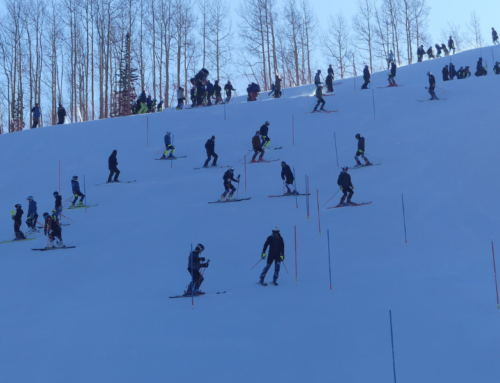The Vonn Way: An unusual trajectory has taken Thomas Vonn to the top
The Vonn Way: An unusual trajectory has taken Thomas Vonn to the top In 1998, Thomas Vonn crushed the giant slalom field at the Dartmouth Carnival, came home to his dorm at St. Lawrence University, and watched the Nagano Olympics on television. Exactly four years later, in Utah, he finished the Olympic super G in ninth place. The nation’s red-hot demand for triple-axles kept NBC from broadcasting Vonn’s performance, however, and the omission angered anyone who knew anything about Vonn’s unlikely route to the top.
In 1998, Thomas Vonn crushed the giant slalom field at the Dartmouth Carnival, came home to his dorm at St. Lawrence University, and watched the Nagano Olympics on television. Exactly four years later, in Utah, he finished the Olympic super G in ninth place. The nation’s red-hot demand for triple-axles kept NBC from broadcasting Vonn’s performance, however, and the omission angered anyone who knew anything about Vonn’s unlikely route to the top.
Back in New York, one of Vonn’s old buddies delivered the best expression of the American ski racing community’s sentiments when he stood up, walked across the room, and kicked in his television screen.
“To do that well on a stage that big was great,” Vonn says. “There wasn’t really a home-field advantage — we’d hardly seen that course before. …You’ve got all your friends there, your parents, thousands of fans, and you’re trying to redeem yourself.”
Redemption indeed. Just weeks before the Games, at Kitzbuhel, Vonn had earned the best result of his life — and then been disqualified on an equipment technicality. Using strips of duct tape to adjust his boot alignment, he had apparently exceeded the 55-mm limit of ski, binding and plate thickness. He still defends himself, insisting that the FIS officials’ calipers don’t compress the materials in the same way as an athlete’s full body weight. This was the argument he made before Mike Kertesz, the Canadian FIS official responsible for equipment evaluations that day.
“Yeah, it got a little heated right there in the finish,” admits Vonn, who was particularly mad, he says, because the testing methods had been changing from day to day. Coaches mediated the finish-area situation, the DQ was upheld, and the next day Vonn met with Kertesz and laid it all out: “I said I wanted to know exactly what all the rules were going to be, in advance, from now on. I told him I just wanted consistency. I mean, this was no joke; this is what I do for a living.”
‘He wasn’t burnt out at 17’
Ski racing didn’t always seem the chosen career path for Vonn. Though he began skiing when he was three, at New York’s Hunter Mountain, he didn’t race until he was 12. And at 17, Vonn hadn’t even qualified for the Junior Olympics, let alone been invited to the USST camps and development projects that tend to funnel athletes into a national team spot.
But then, Vonn joined the New York Ski Educational Foundation (NYSEF) at Whiteface Mountain, where, he says, Horst Webber and Doug Williams made him into the skier he is today. It was good timing. The U.S. Ski Team had just fired Williams, who wanted to prove himself as a coach, and he could see that Vonn was hungry.
“He wanted to race,” Williams recalls. “He wasn’t a star at 12 and 13 with the world on a plate, and maybe that’s why he wasn’t burnt out at 17.”
Vonn kept plugging away, and spent two post-graduate years at the Northwood School before he made the U.S. Ski Team in 1997, a year before the Nagano Games. But after just a half-season on the C team, Vonn was bumped off. Says Williams, “I seem to remember Jesse Hunt said that [Vonn] would never score a World Cup point.”
So Vonn went to college at St. Lawrence, where he could train on the familiar slopes of Whiteface. After handily winning several Carnivals and sneaking across the pond to place well in European FIS races, Vonn competed at the 1998 U.S. Nationals at Jackson Hole and placed 5th in the giant slalom. By 1999 he was back in a U.S. Ski Team uniform — and has since scored 85 World Cup points.
Besides points, Vonn, now 26, has earned a reputation as somewhat of a Renassiance man on the team. He has a 200-plus bowling average and, according to Erik Schlopy, “doesn’t speak Norwegian — even though he can.” Vonn spends much of his free time on the computer, analyzing race videos and making CD compilations for his teammates with footage of all their World Cup runs set to music.
Coaches, meanwhile, often call Vonn a specimen, for his stubborn and scientific approach to success. “He can jump really high,” says Dane Spencer. “He’ll be all skinny after not working out for a month, and then you’ll see him get huge again.”
And then there’s the equipment thing. Vonn was on Volkl for a year, then Rossignol for three years, Salomon for one and Atomic for a summer before switching to Fischer last year. “He’s very anal about his equipment,” says Spencer. “Base bevel is critical. Edge is critical. The big thing for him — he’s ultrasensitive about this — is canting. If Vonn doesn’t have the right brand of tape, he won’t win.”
When Vonn does win, though, some can’t help but examine the unusual way he landed on the team. “It wasn’t easy and there were a lot of distractions,” Vonn says of his detour through college. But he dismisses much of the rhetoric that says the ski team should select more college athletes. “I feel that the USST has been doing the right thing,” he says. “The criteria is clearly written. Any college athlete who meets that criteria will be named to the team. It’s the same standard for everyone.”
And yet Vonn does believe the team could take steps to “keep college athletes hungry to be at the highest level.” He suggests inviting college athletes to stateside time-trials to compete for World Cup starts, similar to how the Gold Cup worked for entries to the Salt Lake Games: “I think it would provide a serious carrot to chase, whereas right now the only way in is to win a Nor-Am title, or grind it out on the Europa Cup, which are all next-to-impossible for a college student to do.”
It’s a perennial debate. One argument is that USSA could tap the financial resources of NCAA and public universities. Another holds that the college teams could churn out mature and educated athletes. Indeed, the average age of male World Cup race-winners last season was 29.
But all that aside, does it really make sense to make Thomas Vonn the poster-child for restructuring the development track? If anything, his career is one long argument against it. Take another look and you’ll see that Thomas Vonn has always laid down his own track.





















